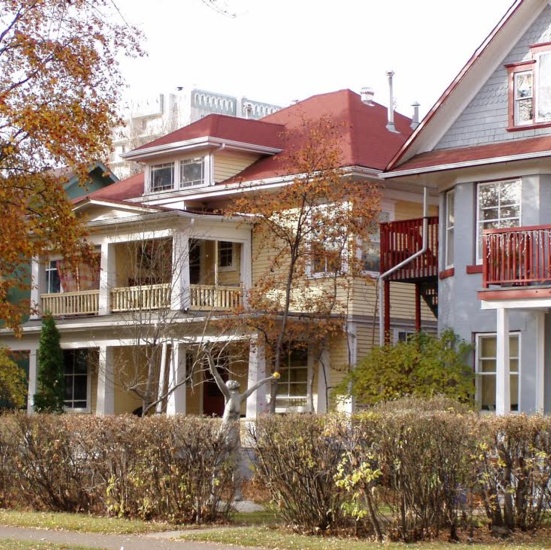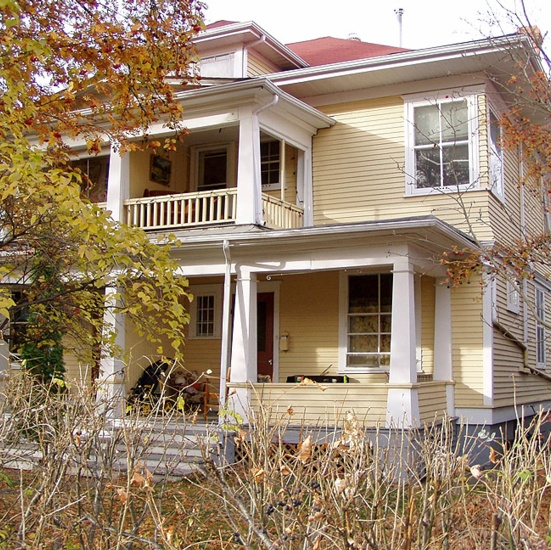Dame Eliza Chenier Residence
“Along with the other heritage buildings in the area, this duplex helps to create a sense of the streetscape in a pre- First World War Edmonton neighbourhood.” ~ Edmonton Historical Board
“Along with the other heritage buildings in the area, this duplex helps to create a sense of the streetscape in a pre- First World War Edmonton neighbourhood.” ~ Edmonton Historical Board
This Edwardian influenced duplex is typical of the Foursquare architectural style, although it is much larger than a single family home of this genre. Named for its owner, Dame Eliza Chenier, this residence features classic Foursquare characteristics: it is symmetrical, box-like, two storeys high, and has a low-pitched hipped roof. The house is clad in timber clapboard, has a dormer window, and a full length timber-clad front porch supported by flared columns. Additional details include bellcast features on the roof and a timber chimney with corbelled capping. A hipped roof central dormer with double windows also extends from the roof. The second storey is accentuated with a small railed porch covered with a gable-ended roof. A solid entablature and boxed eaves give prominence to the strong rooflines. Likewise, wide wooden casing with decorative crowns emphasize the fenestration. Small nine-pane windows sit adjacent to both the timber paneled front and upper balcony doors, with larger double-hung timber windows looking out onto the lower porch. A corniced timber belt course delineates the second storey which features paired corner windows, three one-over-one sash windows, two two-over-two sash windows, and a multi-paned picture window. Separating the brick foundation from the main floor level is a flat belt course. With each side a mirror of the other, the north, south, and rear façades are similar, but there is a flat-roofed addition on the back of the residence which was originally used as a balcony.
Dame Eliza Chenier was a notable female entrepreneur. Joseph Chenier owned a general merchandise store on Jasper Avenue. Three years after he died in 1907, Eliza took out a building permit for this duplex to be built on 12th (112) Street. She asked her neighbour, contractor John L. Lang to build it. He owned the home a few doors to the south. When construction was completed in 1911, Chenier lived in the north side of the duplex until 1926 while, Joseph A. Beauchamp lived in the south side until 1919. Chenier and Beauchamp went into business together, co-owning the Strathcona Hotel from 1912 to 1923. Beauchamp had made a name for himself building the first hotel in Fort Saskatchewan, purchasing the Windsor Hotel (later the Selkirk Hotel), and being the owner and manager of the Cecil Hotel from 1924 until he died in 1949.
Four houses along this street, John L. Lang’s house at 9908-9914, 9918, Dame Eliza Chenier’s house, and the home to the north (9932) form a rare streetscape of surviving middle- and working-class homes from the early 1900s. All the homes on this street were purchased by the City of Edmonton in the 1960s and slated for destruction as the City considered plans to twin the High Level Bridge. Fortunately for these historic homes, those plans were not made manifest. Similarly, these homes were saved from destruction in 2003 when Shirleen Smith and the Oliver Historical Committee campaigned for their historic designation in light of plans for a high-rise to be erected in their stead. Now Municipal Historic Resources, these homes will continue to be a local reminder of residential life in the earliest part of the twentieth century.
Details
Type
Residential
Designation Status
Municipal Historic Resource
Neighbourhood
Time Period
Year Built
1910
Architects
Architectural Styles
Character Defining Elements
Square footprint , Sash windows , Columns , Balloon framed , Timber clapboard cladding , Veranda , Chimney , Balcony , Gable roof , Boxed eaves , Duplex , Cornice , Two storeys , Hipped roof

